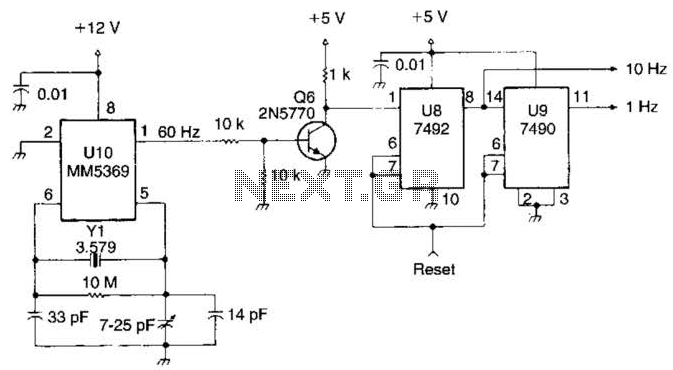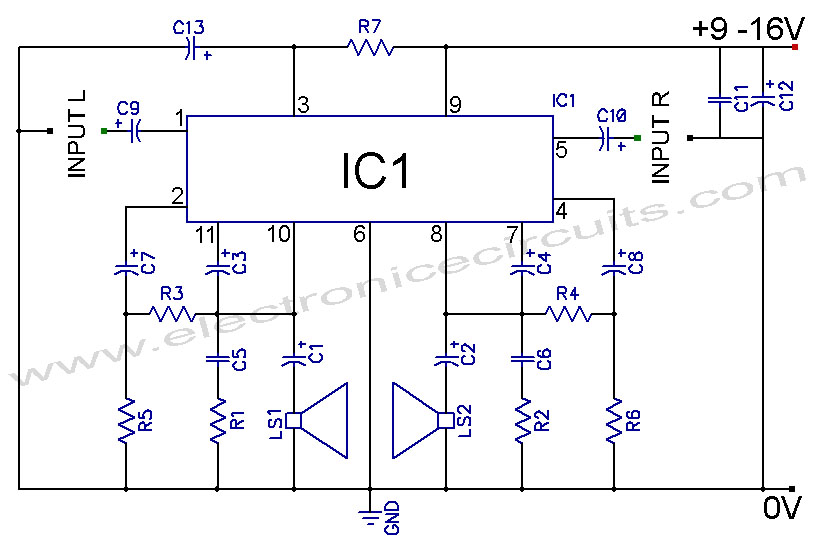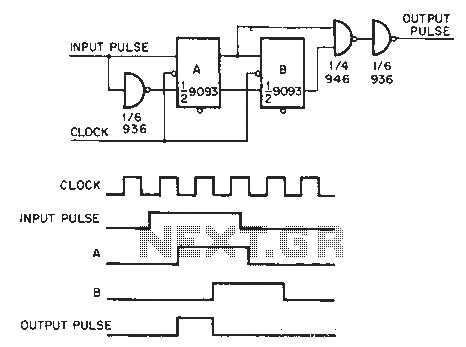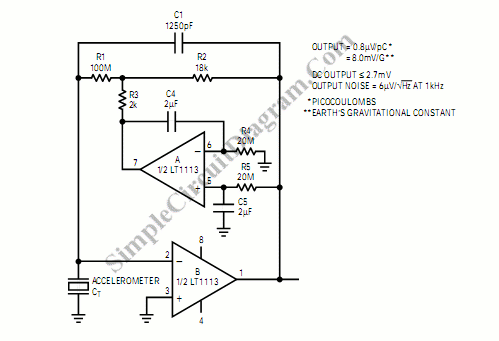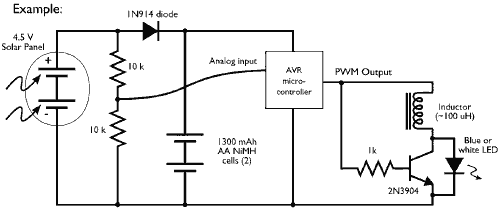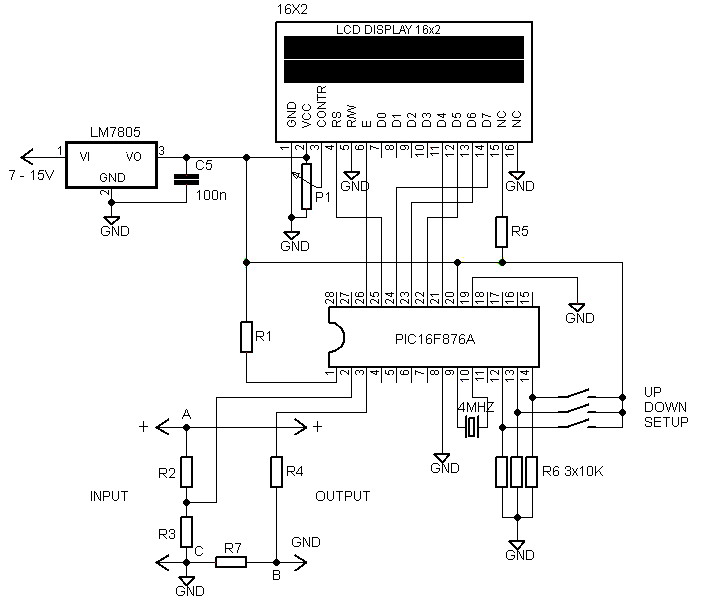
Capacitor Meter Circuit
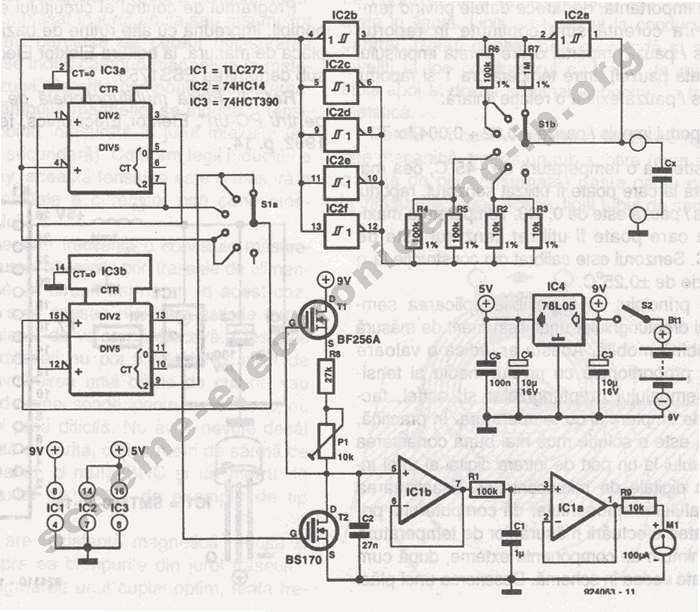
The circuit consists of an oscillator with variable frequency, a frequency divider, and a measurement stage. The oscillator is based on an inverter from a 74HC14 and generates a frequency that is inversely proportional to the capacitance of the capacitor (Cx) placed between its terminals. During each half-period of the signal output from IC3, capacitor C2 is charged by transistor T1. During the other half-period, transistor T2 is activated by the signal, short-circuiting C2. Thus, the maximum voltage across C2 depends on the frequency of the signal. The voltage is fed to buffer IC1b and integrated by resistor R1 and capacitor C1. The capacitor meter presented here can measure capacitances between 100 pF and 1 µF across five measurement ranges, exceeding the capabilities of a typical multimeter or tester. The circuit includes a variable frequency oscillator, a frequency divider, and a measurement stage. The oscillator is based on an inverter gate (IC2a) from a 74HC14 and produces a frequency that is inversely proportional to the capacitance of capacitor Cx connected between its terminals. Cx is the capacitor whose capacitance is to be measured, while R is the resistance selected by switch S1b. With the specified values shown in the schematic, the frequency ranges from approximately 240 Hz (Cx = 1 µF) to 12 kHz (Cx = 100 pF). This frequency is applied to the input of the divider IC3b. During half of each period of the signal at the output of IC3b, C2 charges through transistor T1, while T2 remains off (open). In the other half of each period, T2 becomes conductive, driven by the output voltage of IC3b, short-circuiting C2. Consequently, the maximum charging voltage of C2 is dependent on the frequency of the signal. The voltage is captured by gate IC1b, which acts as a buffer, and is integrated by R1 and C1, delivering a current to the microammeter that is proportional to the frequency of the signal and, therefore, proportional to the capacitance of Cx.
The circuit operates as a capacitance measurement tool by utilizing the principles of oscillation and timing. The 74HC14 inverter is configured to generate a square wave signal whose frequency varies with the capacitance of Cx. The relationship between frequency and capacitance is established through the timing components, where the RC time constant dictates the oscillation frequency. The choice of R and C values allows for a wide measurement range, enabling the circuit to function effectively for small capacitance values.
The use of transistors T1 and T2 facilitates the charging and discharging of capacitor C2, thereby enabling the measurement of the voltage across it, which varies with the frequency of the input signal. The integration stage comprising R1 and C1 smooths the voltage signal, converting it into a proportional current that can be easily read on a microammeter. This design ensures that the circuit can accurately measure capacitance across a specified range, making it a valuable tool for electronics testing and diagnostics.
The flexibility of the circuit is enhanced by the inclusion of a selector switch (S1b), allowing the user to choose different resistance values to optimize the measurement for various capacitance ranges. Overall, the circuit's design combines simplicity with functionality, providing an effective solution for measuring capacitor values that surpasses standard multimeter capabilities.Circuit consists of an oscillator with variable frequency, a divided frequency and measurement stage. The Oscillator is based on a inversor from a 74HC14 and generates a frequency f inversely proportional to the Cx placed between terminals.
During a half periods of each signal his exit from IC3, C2 is loading by T1. During the other half of the pe riod, T2 is brought Conducted by the signal, so that C2 will be shortcircuited. In this way, the maximum voltage C2 depends on the frequency signal. Tension is taken over by repeter IC1b and integrated R1-C1. El medidor de condensadores que aquG se presenta puede medir capacidades entre 100pF y 1uF y en cinco rangos de mediciG³n, mG s de lo que puede decir un multGmetro o tester. El circuito consta de un oscilador de frecuencia variable, un divisor de frecuencia y una etapa de mediciG³n.
El oscilador se basa en una puerta inversora (IC2a) de un 74HC14 y genera una frecuencia f inversamente proporcional a la capacidad del condensador Cx colocado entre sus terminales. Cx es el condensador cuya capacidad se desea medir. donde R es la resistencia seleccionada por S1b. Con los valores mostrados en el esquema, la frecuencia se sitG a entre 240 Hz (Cx = 1uF) y 12 kHz (Cx = 100pF).
La frecuencia es aplicada a la entrada del divisor Ic3b. Durante la mitad de cada periodo de la seG±al en la salida de IC3b, C2 se carga mediante T1, estando T2 en estado de no conducciG³n (abierto). Durante la otra mitad del cada perGodo, T2 entra en conducciG³n polarizado por la tensiG³n de la salida de IC3b, poniendo en cortocircuito a C2.
De esta manera, la mG xima tensiG³n de carga de C2 dependerG de la frecuencia de dicha seG±al. La tensiG³n es tomada por la puerta IC1B, que actG a como repetidora, y es integrada por R1-C1, entregando sobre el microamperGmetro una corriente proporcional a la frecuencia de la seG±al, y con ello, proporcional a la capacidad de Cx. 🔗 External reference
The circuit operates as a capacitance measurement tool by utilizing the principles of oscillation and timing. The 74HC14 inverter is configured to generate a square wave signal whose frequency varies with the capacitance of Cx. The relationship between frequency and capacitance is established through the timing components, where the RC time constant dictates the oscillation frequency. The choice of R and C values allows for a wide measurement range, enabling the circuit to function effectively for small capacitance values.
The use of transistors T1 and T2 facilitates the charging and discharging of capacitor C2, thereby enabling the measurement of the voltage across it, which varies with the frequency of the input signal. The integration stage comprising R1 and C1 smooths the voltage signal, converting it into a proportional current that can be easily read on a microammeter. This design ensures that the circuit can accurately measure capacitance across a specified range, making it a valuable tool for electronics testing and diagnostics.
The flexibility of the circuit is enhanced by the inclusion of a selector switch (S1b), allowing the user to choose different resistance values to optimize the measurement for various capacitance ranges. Overall, the circuit's design combines simplicity with functionality, providing an effective solution for measuring capacitor values that surpasses standard multimeter capabilities.Circuit consists of an oscillator with variable frequency, a divided frequency and measurement stage. The Oscillator is based on a inversor from a 74HC14 and generates a frequency f inversely proportional to the Cx placed between terminals.
During a half periods of each signal his exit from IC3, C2 is loading by T1. During the other half of the pe riod, T2 is brought Conducted by the signal, so that C2 will be shortcircuited. In this way, the maximum voltage C2 depends on the frequency signal. Tension is taken over by repeter IC1b and integrated R1-C1. El medidor de condensadores que aquG se presenta puede medir capacidades entre 100pF y 1uF y en cinco rangos de mediciG³n, mG s de lo que puede decir un multGmetro o tester. El circuito consta de un oscilador de frecuencia variable, un divisor de frecuencia y una etapa de mediciG³n.
El oscilador se basa en una puerta inversora (IC2a) de un 74HC14 y genera una frecuencia f inversamente proporcional a la capacidad del condensador Cx colocado entre sus terminales. Cx es el condensador cuya capacidad se desea medir. donde R es la resistencia seleccionada por S1b. Con los valores mostrados en el esquema, la frecuencia se sitG a entre 240 Hz (Cx = 1uF) y 12 kHz (Cx = 100pF).
La frecuencia es aplicada a la entrada del divisor Ic3b. Durante la mitad de cada periodo de la seG±al en la salida de IC3b, C2 se carga mediante T1, estando T2 en estado de no conducciG³n (abierto). Durante la otra mitad del cada perGodo, T2 entra en conducciG³n polarizado por la tensiG³n de la salida de IC3b, poniendo en cortocircuito a C2.
De esta manera, la mG xima tensiG³n de carga de C2 dependerG de la frecuencia de dicha seG±al. La tensiG³n es tomada por la puerta IC1B, que actG a como repetidora, y es integrada por R1-C1, entregando sobre el microamperGmetro una corriente proporcional a la frecuencia de la seG±al, y con ello, proporcional a la capacidad de Cx. 🔗 External reference
